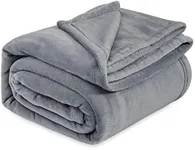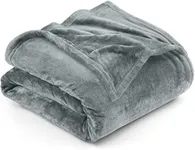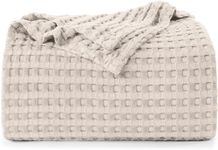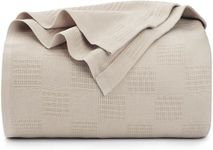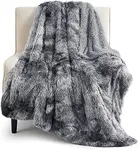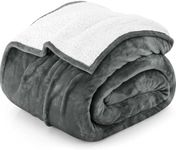Buying Guide for the Best Winter Blankets
Choosing the right winter blanket is essential for ensuring a warm and comfortable night's sleep during the colder months. When selecting a winter blanket, it's important to consider various factors such as material, weight, size, and warmth. Understanding these key specifications will help you make an informed decision and find the perfect blanket to keep you cozy all winter long.MaterialThe material of a winter blanket is crucial as it determines the blanket's warmth, softness, and breathability. Common materials include wool, down, cotton, and synthetic fibers. Wool is known for its excellent insulation and moisture-wicking properties, making it ideal for very cold climates. Down blankets are lightweight yet incredibly warm, perfect for those who prefer a lighter feel. Cotton blankets are breathable and soft, suitable for milder winters or those who tend to overheat. Synthetic fibers like polyester can mimic the warmth of wool or down but are often more affordable and easier to care for. Choose a material based on your warmth needs, any allergies, and personal comfort preferences.
WeightThe weight of a winter blanket affects how warm and cozy it feels. Blankets come in various weights, from lightweight to heavyweight. Lightweight blankets are suitable for mild winters or for layering with other bedding. Medium-weight blankets offer a balance of warmth and comfort, making them versatile for different temperatures. Heavyweight blankets provide maximum warmth and are ideal for extremely cold conditions. Consider your local climate and personal preference for blanket heaviness when selecting the right weight for you.
SizeThe size of the blanket should match your bed size to ensure full coverage and comfort. Standard sizes include twin, full, queen, and king. A blanket that is too small may not provide adequate warmth, while an oversized blanket can be cumbersome. Measure your bed and consider how much overhang you prefer. If you share your bed, a larger size may be more comfortable to ensure both sleepers are covered. Choose a size that fits your bed and meets your coverage needs.
WarmthThe warmth of a winter blanket is determined by its material, weight, and construction. Some blankets are designed with additional insulation or thermal properties to provide extra warmth. Consider the blanket's warmth rating or tog rating, which indicates its thermal insulation. A higher tog rating means more warmth. If you live in a very cold area or tend to feel cold at night, opt for a blanket with a higher warmth rating. For milder winters or if you tend to overheat, a lower warmth rating may be more suitable. Assess your personal warmth needs and the typical winter temperatures in your area to choose the right level of warmth.
BreathabilityBreathability refers to how well a blanket allows air to circulate, preventing overheating and ensuring a comfortable sleep. Natural fibers like cotton and wool are generally more breathable than synthetic materials. If you tend to get hot at night or live in a climate with fluctuating temperatures, a breathable blanket can help regulate your body temperature. Look for blankets with moisture-wicking properties to keep you dry and comfortable. Choose a breathable blanket if you prioritize temperature regulation and comfort throughout the night.
Care InstructionsCare instructions are important to consider for maintaining the longevity and cleanliness of your winter blanket. Some materials require special care, such as dry cleaning or hand washing, while others are machine washable. Wool and down blankets often need more delicate care, whereas cotton and synthetic blankets are usually easier to clean. Consider your willingness and ability to follow specific care instructions. If you prefer low-maintenance bedding, opt for a blanket that is machine washable and easy to care for. Choose a blanket with care instructions that fit your lifestyle and ensure it remains in good condition.
